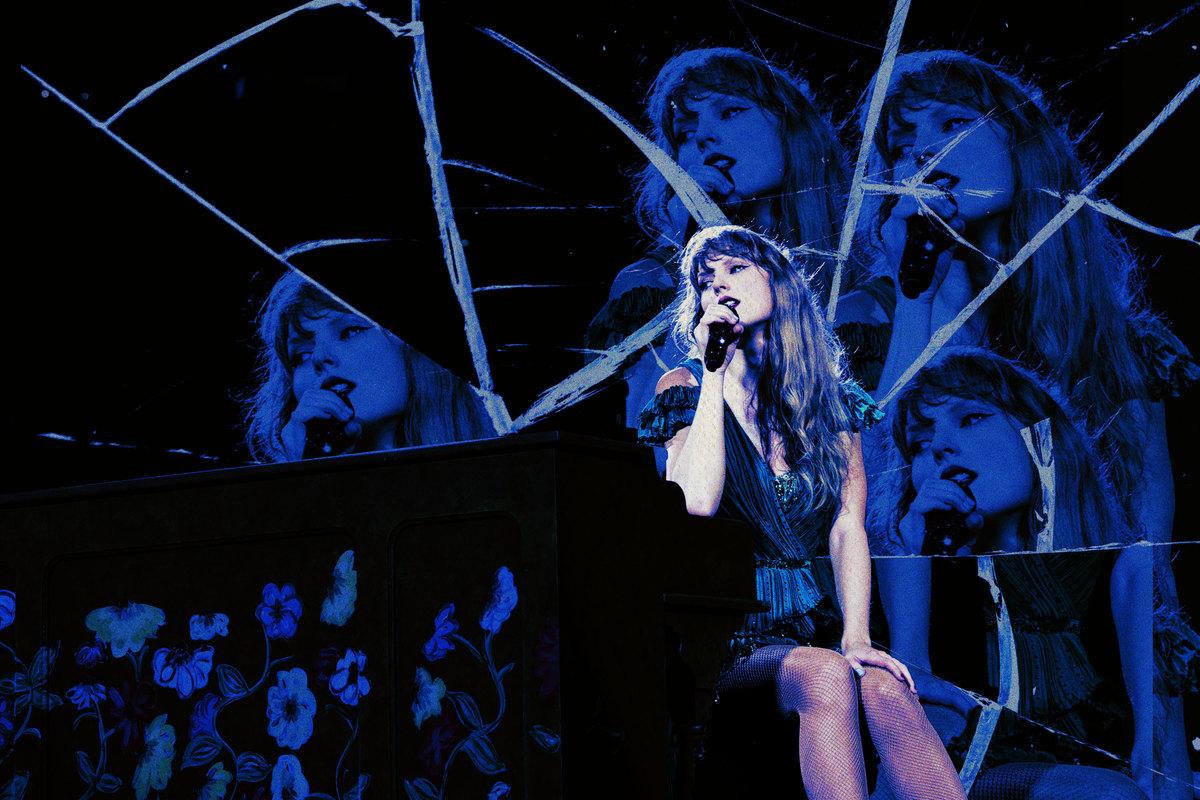
Two weeks ago, Taylor Swift changed a song on the set list of The Eras Tour. In the first of three shows at AT&T Stadium in Arlington, Texas, during the section featuring songs from her woodsy, sepia-tinted pandemic record Folklore, she swapped out “Invisible String” for “The 1.”
Swift songs are stories. “Invisible String” is a love song about finding the person you’re meant to be with. “The 1,” though, is a wistful breakup song. As in, “But it would’ve been fun / if you would’ve been the one.” Was the change merely a way to keep her fans, who had been scrutinizing the set list from the tour’s first two stops and scouring livestreams, guessing? Or was this something deeper, an Easter egg hinting at something about her life or her work?
Ten days after that song swap, we may have gotten our answer when Entertainment Tonight reported that Swift and her boyfriend of six years, Joe Alwyn, had broken up. ET reported that the breakup had happened a few weeks prior, around the start of Swift’s tour, that it was reportedly amicable and “not dramatic,” and that “the relationship had just run its course.” Two days after the initial news, People reported that the breakup was due to differences in Swift’s and Alwyn’s personalities. “They had plenty in common and fell in love in a safe bubble while she was retreating from the world during Reputation,” People’s source said, citing a period when Swift scaled back her public life after a slew of bad press and recorded her sixth album. “Then the pandemic hit, and they were locked down together and able to continue growing their relationship in this insulated way. But he didn’t really ‘know’ her yet outside of that bubble.”
People reported that Swift and Alwyn bonded over their mutual love of art and creative passions and had talked about getting married within the last year, but that Alwyn “has struggled with Taylor’s level of fame and the attention from the public.”
Since the news broke, neither Swift nor Alwyn has commented on the breakup. Swift has been seen out in New York a couple of times this month. Last week, she was photographed leaving dinner at Via Carota—a West Village favorite for elegantly rustic Italian food, see-and-be-seen street-facing windows, and a cult favorite green salad—to the clear delight of a neighborhood corgi; on Monday she dined out at Lure Fishbar in SoHo, a celebrity favorite.
The Eras Tour resumed in Tampa last weekend with “The 1” still on the set list and “Invisible String” still absent, but the closest Swift came to acknowledging the news was a thumbs-up she gave to a fan holding a sign that read, “You OK?,” a nod to Swift’s music video for “You Belong With Me.”
If you happen to have the pleasure of functioning as your family’s/friend group’s/office’s designated Swiftie, you have probably felt compelled to prepare an official statement for when you’re asked to comment on the breakup of two 30-somethings you have likely never met. What happened? Were they really secretly married? Did you hear that Karlie Kloss moved into her neighborhood? (Who really knows; that is a ridiculous but weirdly persistent rumor; two celebrities living in downtown Manhattan is not notable.) You have also probably felt some genuine sadness, and maybe some self-consciousness about feeling genuine sadness over a celebrity breakup.
Intellectually, I have a lot of respect for the awareness it must take to acknowledge you’ve grown apart from someone after six years as well as the strength to act on it—that sounds really hard, but like the mature and right thing to do. Also, I am sad we won’t get to see Alwyn sneak the occasional picture of one of Swift’s cats into the final slides of a photo dump anymore—it was one of the only ways in which the notoriously private couple ever acknowledged their relationship on social media—because that was very sweet. Or, to put it how I did to friends via text the night the news broke: “WHY AM I CRYING?!?!?!?!?!!”
There will be dissertations written on parasocial relationships that reference the “mourners” who descended on Cornelia Street in the West Village, many of them crying and placing flowers in front of the apartment Swift was renting there when she and Alwyn first got together (the street is famously the subject of one of her songs). Some sang songs and got yelled at by the neighbors. “I was trying to explain to my boyfriend—it’s like if the Obamas broke up,” an NYU student named Susanna told Vulture.
All of this was bound to happen because it’s hard to be a fan of Swift without taking her pretty personally. This is, in part, because of the home-baked cookies at the secret sessions, the Taylurking, the documentary, the behind-the-scenes concert footage, and the fact that so many of us quite literally grew up with her music. Most fundamentally, though, it’s because her songs are so personal. She told us about the scarf, the 27-second voicemail, and the dive bar on the East Side, and it’s very easy to take that as an invitation to be all up in her business.
After the breakup news broke, the search for context clues began. Moments from the first weeks of her tour had gained new meta-narrative weight. The tears Swift shed onstage during an early performance of the bridge in “Champagne Problems”—“She would’ve made such a lovely bride / what a shame she’s fucked in the head”—seemed to have been revealed as the product of raw pain rather than artistic emotion. The switch from “Invisible String” to “The 1” seemed similarly autobiographical. In Tampa, she introduced the show in part by saying that some songs “may have started out being written about my life, or something I felt at one point,” and the use of past tense seemed notable.
To some degree, Swift tried to prevent this from happening, to put the cat back in the bag. When she released Folklore and Evermore in 2020 and 2021, respectively, she made sure to explicitly note that those albums were not entirely about her life.
“I found myself not only writing my own stories, but also writing about or from the perspective of people I’ve never met, people I’ve known, or those I wish I hadn’t,” Swift wrote on Twitter after Folklore’s release in 2020.
I should admit that the idea that her quarantine albums are full of character studies, as opposed to personal stories, never clicked for me. Her writing is too signature; even when it has an altered point of view, I still hear it coming from Taylor Swift. “The 1,” for example, was a song about someone who’d gone through a breakup being sung by someone in a longtime relationship. On its face, it was one of those alternate-POV stories. But when Swift begins the song, and the entire Folklore album, by singing, “I’m doing good / I’m on some new shit,” don’t you hear her singing to you?
And sure, “The Last Great American Dynasty” is about the wacky Standard Oil heiress Rebekah Harkness (LOL), but it is also about Taylor Swift. “There goes the maddest woman this town has ever seen”—the turn toward autobiography comes a lot sooner than the final reveal that Taylor is the current owner of Harkness’s old oceanside mansion in Rhode Island.
Even Folklore’s “Cardigan,” “August,” and “Betty,” a trio of songs that together tell different sides of what Swift has described as a “teenage love triangle,” manage to include a layer of Swiftian lore. Three characters mentioned in the songs are Betty, James, and Inez, which happen to be the names of Blake Lively and Ryan Reynolds’s kids, and did you know who’s great friends with Blake and Ryan? Taylor Swift. And so on and so forth. Even the songs that Aren’t About Taylor Swift manage to be About Taylor Swift.
And lest we forget, there are songs on these albums that are Definitely About Taylor Swift. “Invisible String” includes several specific references to Swift’s relationship with Alwyn, like the frozen yogurt shop where he worked as a kid (it is called Snog’s, and we will always have that, if nothing more) and a three-year anniversary trip they took together, when a waitress noticed Swift “look[s] like an American singer.” Another of that song’s best lyrics is unmistakably autobiographical: “Cold was the steel of my ax to grind for the boys who broke my heart / Now I send their babies presents.” In “My Tears Ricochet,” she sings about stolen lullabies and mutually assured destruction, seemingly a reference to Swift’s feelings about her former record label boss, who sold her master recordings against her will. A refrain in the form of a question on “Peace”—“Would it be enough if I could never give you peace?”—shares a central anxiety of Swift’s, that the inability to go out for a casual dinner or not be the subject of rumors and conspiracy theories could get in the way of a relationship. Gulp.
I have always heard as much of her in those albums as in her other work, and I was reminded of that when “The 1” and “Champagne Problems” became part of the breakup newsreel. But I do think Swift was intentionally trying to pull some sort of curtain over her inner life by leaving the perspectives of those songs and the more recent ones on her 2022 album, Midnights, undefined, so maybe the takeaway is just that she’d like to keep it to herself and we should all go touch some grass. But about a thousand words ago, I mentioned the impulse to have a clear statement on the matter, so here it is: Breaking up is hard, doing so in public seems harder, it’s nearly impossible for a Taylor Swift song to not, on some level, be about Taylor Swift, and if you’re looking for breakup songs, I think we already got them.

